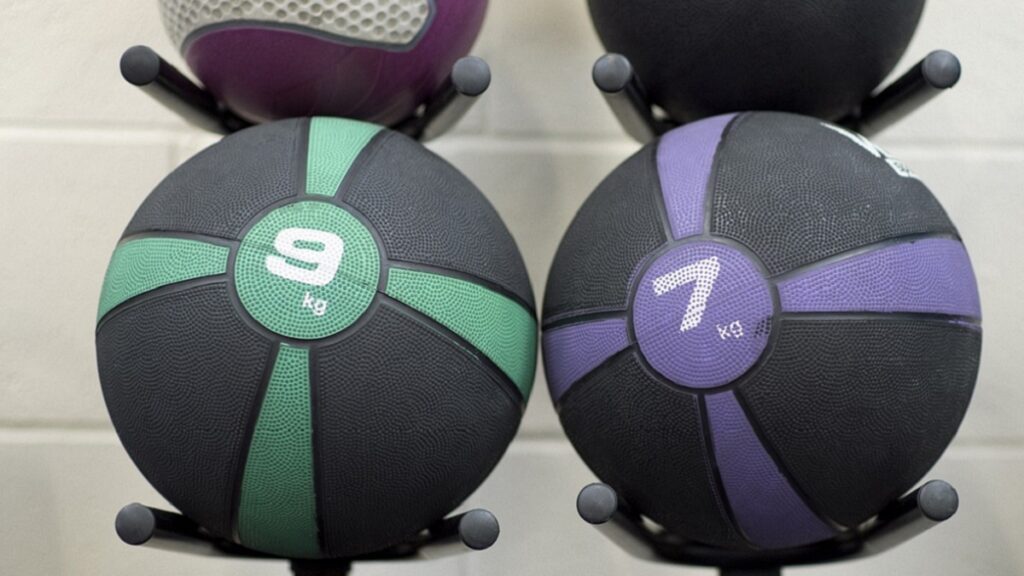A rotator cuff is a muscle group consisting of several muscles and tendons that maintain stability and the overall health of your shoulders and upper arm (humerus). Hence, bodybuilding rotator cuff exercises are essential to ensure your shoulders’ strength and stability. The rotator cuff comprises supraspinatus, Infraspinatus, teres minor, and subscapularis.
So, what are the exercises that can work the rotator cuff?
The exercises that can work the rotator cuff include the dumbbell lateral raise, internal and external rotations, inverted row, and overhead press. A strong and stable rotator cuff can resist forces damaging your shoulders. Also, they improve your posture and increase your motion range.
This article reviews 8 rotator cuff workouts to help you maintain the healthy status of this part of your shoulders and upper body. Let’s get started.
Bodybuilding Rotator Cuff Exercises: What Are the Ideal Choices?
The ideal choices for bodybuilding exercises for the rotator cuff include the following:
- Dumbbell lateral raise
- Standing cable external rotations
- Seated dumbbell external rotation
- Cable internal rotations
- Standing barbell overhead press
- Inverted row
- Lawnmower pull
- Dumbbell reverse fly
Let’s look at each of the above bodybuilding workouts.
1. Dumbbell Lateral Raise
Lateral raise is an abduction exercise that trains your rotator cuff’s strength and function: The supraspinatus abducts your arm, while the lower rotator cuff muscles hold the humeral down against the deltoids’ pull. It’s one of the bodybuilding rotator cuff exercises that target your upper back’s trapezius muscles and the deltoids (lateral and anterior).
Using the proper form of this workout enhances muscle growth (hypertrophy process) and improves your motion range. Also, since it’s a lightweight exercise, you can use it as a foundational workout to build strength for more advanced exercises.
Here are the dumbbell lateral raise instructions:
- Grab your dumbbells in each hand, and stand tall with your feet hip-width apart. Keep your arms at your sides and palms facing in.
- Set your body in the correct posture by rolling back the shoulders, engaging the core, and looking straight ahead. Grip the floor with your feet to build stability.
- Slowly and simultaneously move your dumbbells slightly away from your body (starting point) and pause. The pausing keeps tension on the side delts: Disengages the trapezius muscle briefly to engage the deltoids.
- Raise the dumbbells to a point where your arms are almost straight and your elbows at shoulder height as you inhale.
- Pause and hold at the movement’s top for about a second.
- Slowly (twice as long as the lifting time) lower the weights back to the starting position as you exhale.
- Repeat for the required number of reps.
Tips:
- Since lateral raise is an isolation exercise, you should use light weights and focus on muscle contraction and stretching.
- Avoid using momentum swinging up of your dumbbells. Instead, have slow and controlled rep timing to get the best results.
- Keep your wrists below the elbows by tilting the weights downward when raising them.
- Start with weights you can control and maintain good technique for 2-3 sets of 8-12 reps.
- Avoid forward neck craning or chin dropping as you perform your workouts.
2. Standing Cable External Rotations
The external rotation exercises involve rotation away from your body’s center. For instance, pushing your elbow away from your side. You can perform these body-building rotator cuff exercises with a cable pulley (like in our case), an elastic band, or a dumbbell. Moreover, keep your arm steady against your side and ensure you rotate it against the resistance direction.
Here are the standing cable external rotations instructions:
- Stand next to a cable machine by your side.
- Lock your elbow at 90 degrees (L-shape), positioning your forearm across your belly. Set the cable at forearm height or slightly below.
- Grab the cable with your arm, pull it across your body, and return your arm to the L-shape position (starting point). Keep your core tight, the spine neutral, and your shoulders set back.
- Locking your elbow with your forearm tucked close to your body, pull the cable away by rotating your shoulder outwards and moving your forearm across your body. Exhale as you make the outward movement.
- Hold for about 2 seconds, and slowly and controllably reverse the movement: Pull the cable towards your body by rotating your inward and moving your arm across your body. Inhale as you make the inward movement.
- Repeat for your desired reps and switch to the other side.
Tips:
- Keep your elbow at 90 degrees and locked to your side. Put a towel between your elbow and body; if it drops, the elbow isn’t locked.
- Ensure your forearm and elbow are tucked throughout the exercise.
- Always exhale as you push the cable away from your body and inhale as you pull it back.
3. Seated Dumbbell External Rotations (From the Knee)
The external rotation variation targets the infraspinatus muscle of the rotator cuff, which provides stability to the shoulder joints. The infraspinatus muscle’s primary function is rotating the long arm bone (humerus) away from the body.
You perform the bodybuilding rotator cuff exercises from the knee while seated and placing your arm on your knee.
Here are the seated dumbbell external rotations instructions:
- Sit on a bench and lift one of your feet to rest flat on the bench with your knee bent.
- Place your elbow on the top of the knee (at a 90 degrees angle) with the fist pointing to the ceiling.
- Rotate your shoulder 90 degrees until your forearm is parallel to the floor. The elbow should remain parallel to the ground, and the forearm shouldn’t go lower than that position.
- Slowly raise the forearm back to the start point (perpendicular to the ceiling) by rotating the shoulder externally.
- Repeat for the desired reps and switch to the other side.
Tips:
- Maintain a 90-degree angle bent of your elbow throughout the exercise.
- Avoid lowering your forearm below the ‘parallel-to-the-floor’ position.
- Only rotate at the shoulder joint.
4. Cable Internal Rotations
Rotator cuff internal rotations involve turning your shoulders towards your body’s center: Rotates the upper arm towards the front side of your torso, bringing the elbow to your body. These bodybuilding exercises target the anterior rotator cuff muscles (subscapularis).
Here are the cable-internal rotation instructions:
- Stand next to a low cable machine by your side.
- Hold the cable’s arm in line with your waist at an arm-length distance.
- Pull the handle towards your body, maintaining the elbow by your side at a 90-degree angle.
- Slowly rotate the upper arm internally, bringing the forearm across the abs. You’ll feel a stretch in your shoulder muscle.
- Hold for about a second or two and return to the starting position.
- Repeat for the desired reps and switch to the other arm.
Tips:
- Use light weights for the exercise to be successful. The heavy ones can result in injury and work on larger muscles instead.
- Place a rolled-up towel between your body and the elbow for additional comfort and the exercise’s effectiveness.
5. Standing Barbell Overhead Press
Overhead presses are among the fantastic bodybuilding rotator cuff exercises. The workouts train the rotator cuff’s stabilization function naturally, enhancing the strength and mobility of your shoulders.
The best approach for doing these exercises at home is to start with no weight, move to water-filled pressing bottles, and then move to heavier weights gradually.
Here are the standing barbell overhead press instructions:
- Set the barbell in a rack and raise it to about chest height.
- Stand with your feet shoulder-width separate, toes facing slightly out, core engaged, glutes contracted, and looking straight ahead.
- Grab the bar with an overhand grip, your hands slightly wider than shoulder-width apart, and the bar rests against your palm’s heels.
- Inhale and lightly brace the core as you unrack the bar. Keep your elbow tucked in and your wrist tacked above.
- Rest the bar against your front delts as you step back from the bar.
- Press the bar upward until your arms are straight and past your head as you exhale.
- Hold for about a second and lower the bar controllably to the starting point.
- Repeat for the required reps.
Tips:
- Warm up properly for the exercise by starting light and increasing weight gradually.
- ‘Screw’ your feet on the ground to avoid using them to lift the bar.
- Use a full grip: Wrap your fingers around the bar and squeeze it as you press it to add strength to the lift.
- Avoid winging out by keeping your arms straight and elbows slightly inward.
- Avoid leaning or swaying when moving the bar past your face. Instead, tuck your chin and move the head slightly backward.
- Your entire body should remain aligned while the lower back remains neutral throughout the movement.
- Complete the lockout phase and activate the upper back muscles by shrugging your shoulders at the movement’s top.
6. Inverted Row
The workout involves lying face up beneath a barbell in a Smith machine or a squat rack and pulling your body towards the bar. Besides being among the bodybuilding rotator cuff exercises, it also works the biceps, forearms, and lats, maintaining a neutral spine.
Here are the inverted row instructions:
- Take your position before a Smith machine or squat rack.
- Set the bar to an appropriate position: High enough to hold onto it with your arms extended under it and your body off the ground.
- Lie under the bar, looking up, and grip (overhand) the bar with your hands slightly wider than shoulder-width apart. Your body will be slightly off the ground with heels touching the ground.
- Brace the lower back and keep your body (torso to feet) in a straight line by contracting your glutes and core muscles.
- Pull up your body towards the bar to the point where your chest almost touches the bar by moving the elbows downward. You can adjust the bar to your desired position for more comfort.
- Hold for a minute or two at the top of the movement as you squeeze your shoulder blades.
- Slowly lower your body to the starting position by fully extending your arms.
- Repeat for the desired reps.
Tips:
- Take time to identify the correct body position and bar height: A higher position eases the movement and vice versa.
- Keep your body straight from torso to feet by engaging the core, with the heels being the only contact with the ground.
- Although you can use an overhand or underhand grip, using the former (slightly wider than shoulder width) as a starter is ideal.
- Keep the movements slow and under control.
- Don’t position your elbows out wide but at 45 degrees or less to prevent shoulder injury.
- Using more body weight, you can ease the performance by placing your feet on a bench to increase the resistance.
7. Lawnmower Pull
A lawnmower pull is one of the bodybuilding rotator cuff exercises and a modification of the dumbbell row. In addition to the shoulders, the exercise strengthens various muscle groups, including the back, core, and legs.
Here are the lawnmower pull instructions:
- Stand with your feet at a shoulder-width apart position.
- Set the resistance band diagonally across your body: Place one end of the resistance band under the right foot and hold the other end with your left arm.
- Keep your right hand on your hip, with unlocked knees and a slightly flexed waist, for the band-holding arm (left) is parallel to the right knee.
- Slowly straighten up as you pull your elbow across the body towards your outside ribs, with relaxed shoulders and squeezed shoulder blades.
- Repeat for the required reps and switch to the other side.
Tips:
- Maintain relaxed shoulders and squeeze your shoulder blades together during the movements.
8. Dumbbell Reverse Fly
The workout is among the excellent bodybuilding rotator cuff exercises that strengthen your shoulders and upper back. You can do the exercises using resistance bands or dumbbells. Additionally, you must bend at 45 degrees and keep the elbows static and slightly flexed while the arms pull.
Here are the dumbbell reverse fly instructions:
- Sit on a bench with your knees bent and dumbbells in your hands.
- Lean forward at 45 degrees, arms hanging at your calves, and elbows slightly bent (shouldn’t hang loose or locked).
- Raise the dumbbells until the elbows reach shoulder level without straining your neck — you’ll feel the movements work the upper back and shoulders.
- Lower the weights to the starting point — more tension across your shoulders and upper back.
- Repeat for the desired reps.
Tips:
- Start with lighter weights and add the load progressively as your muscles strengthen.
- Avoid swinging the weight; use the upper back for motion control.
- Don’t arch or hunch your back during the movement.
- Avoid straining your neck.
What Are the Benefits of Rotator Cuff Muscle Exercises?
There are various benefits of bodybuilding rotator cuff exercises, including the following:
- Reduces pain in the shoulder joints: The workouts strengthen the muscles, enabling them to provide maximum support to the joints.
- Maintains proper functionality and daily activities such as object pulling and pushing.
- Supports healthy cartilage: Your joint cartilage requires movement and some stress to stay fit due to the synovial fluid presence.
- It’s incorporated with other relevant exercises to reduce postal and neck pain by providing a functional and stable support base.
- Serves as an excellent pre-operation conditioning phase for shoulder management, thus, optimizing the pre-surgical function.
- You can have the exercises as foundational workouts as they can be performed in low functional positions.
- Provides strength and prevents bone friction and dislocation, reducing pain.
- Enhances the shoulder joint range of motion and functionality.
- Improves the stability and integrity of your shoulders.
- Builds the shoulder joint surrounding muscles.
- Corrects rotator cuff imbalances.
FAQ
Can You Lift Weights With a Rotator Cuff Injury?
No, you can’t lift weights with a rotator cuff injury. Hence, you should avoid bodybuilding rotator cuff exercises when your rotator cuff is injured. The movements can cause additional stress and further injury.
Is Bench Press Good for Rotator Cuff?
Yes, a bench press is good for the rotator cuff when done correctly. Otherwise, the workout can cause rotator cuff injuries, instability, or shoulder impingement. Also, the dumbbell variation is safer than the barbell one.
Do Push-Ups Strengthen the Rotator Cuff?
Yes, push-ups strengthen the rotator cuff. You can use them for training the muscle or treating rotator cuff-related pain. Also, the exercise works shoulder muscles, triceps, and chest muscles.
How Long Does it Take for a Rotator Cuff to Strengthen?
It takes 5-6 weeks for the rotator cuff to strengthen. However, it may be longer when recovering from an injury: 6 weeks for bone healing, 3 months for strong bone attachment formation, and about 6-9 months for complete bone healing.
Conclusion
Your rotator cuff is an important muscle in the functionality and overall health of your shoulders and the upper arm. The group of muscles enhances the former’s stability and the latter’s movement. Therefore, ensuring the fitness of this muscle is vital for the smooth performance of your daily activities.
Thankfully, we have compiled a list of 8 practical bodybuilding rotator cuff exercises with their correct form instructions and helpful tips to help you keep your rotator cuff in check. The workouts minimize the injury risk, increase your motion range, improve your posture, and build your confidence for advanced training.



